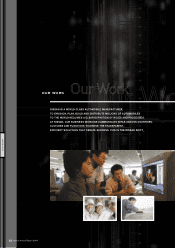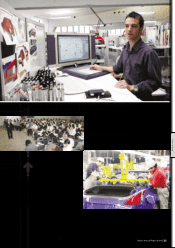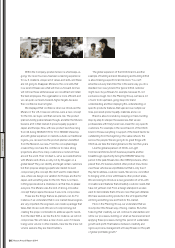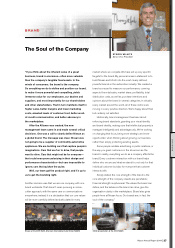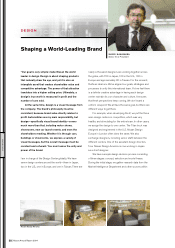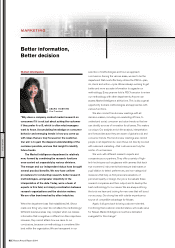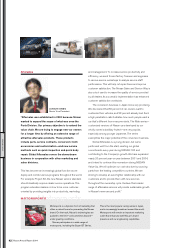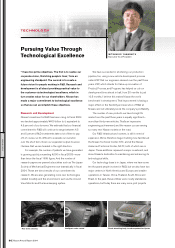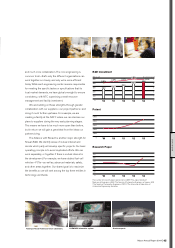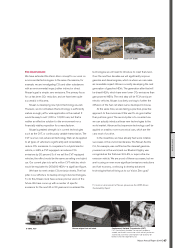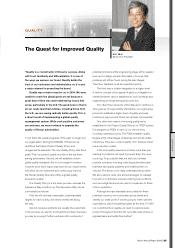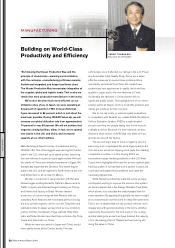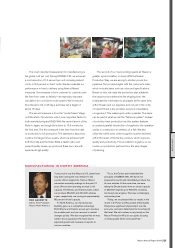Nissan 2005 Annual Report Download - page 43
Download and view the complete annual report
Please find page 43 of the 2005 Nissan annual report below. You can navigate through the pages in the report by either clicking on the pages listed below, or by using the keyword search tool below to find specific information within the annual report.
Nissan Annual Report 2004 41
OUR WORK
YUSUKE SEKIGUCHI
Vice President
Sales & Marketing
“In 2003, I was the “pilot”—essentially the project
leader—of a cross-functional team that redefined the
traditional sales function as a marketing function.
Now I cover car sales as well as traditional marketing
activities such as advertising and sales promotion.
This is part of our effort to address one of the most
competitive auto markets in the world—Japan.
Our dealers conduct sales activities in the
marketplace, and our role is to ensure that what they
do reflects Nissan’s plans. We also gather customer
feedback from the showroom to see how we can
improve processes. Direct communication through online
outlets is another new way of reaching out to customers.
Although the total market in Japan was down in 2004, we
managed to pick up market share. The two halves of the
year were completely different, however. The first half was
the ‘dry season’—where we didn’t have any new model
introduction for over 12 months. We underestimated the
impact that would have on our business, and the dealers
had a tough time because of it. Then we organized the
SHIFT_ event in the second half of the year, and for the
first time ever introduced six new models simultaneously.
This completely changed the playing field. While it was
a challenge for the dealers to launch six models in five
months, it had a significant and positive impact.
Japan’s population peaks in 2006, and automobile
demand is expected to decline thereafter. With this in mind,
we’ve been focusing intensively for the past three years on
building customer relationships. We realize we must
increase and enrich our contact points with customers to
raise our market presence. To this end, we decided to retail
the full lineup through both our Red and Blue dealer
channels, which formerly offered different products.
Our next task is to improve the quality of the sales and
service process. We have already upgraded the
management of our brand identity through various
methods. For example, individual dealers used to handle
newspaper insert production. We moved all insert
production to headquarters, which not only reduced costs
but also created a more powerful, uniform communication
to customers. Today, 15 percent of our showroom traffic is
generated from these inserts, an increase from 6 percent
prior to centralization.
The introduction of the Tiida provided an interesting
test case in interactive communications for us. Not long
before we launched the car, blogging became very popular
in Japan, as it has been elsewhere. There are many car-
related blogs where people share information about their
favorite cars. As an experiment, we started a blog about the
Tiida and encouraged people to comment on the car. This
was the first proactive usage of automotive blog in Japan
and brought a tremendous response—it actually became
the market leader in terms of unique visits. The blog proved
to be an amazingly effective way to generate word-of-mouth
and communication between Nissan and its customers, and
we will continue to utilize this channel in various ways.
Another positive change in our division is a more
cross-functional way of doing business. We communicate
frequently with upstream functions such as Design,
Product Planning and Communication through V-up and
cross-functional activities. This is an essential exchange,
because when Nissan creates a new product or service,
we are responsible for communicating the unique value we
provide to the customer through ‘SHIFT_ points.’ We are
demand creators, and that is how we create value for
the company.”



